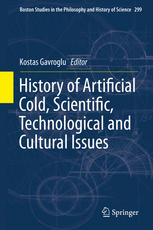

Most ebook files are in PDF format, so you can easily read them using various software such as Foxit Reader or directly on the Google Chrome browser.
Some ebook files are released by publishers in other formats such as .awz, .mobi, .epub, .fb2, etc. You may need to install specific software to read these formats on mobile/PC, such as Calibre.
Please read the tutorial at this link: https://ebookbell.com/faq
We offer FREE conversion to the popular formats you request; however, this may take some time. Therefore, right after payment, please email us, and we will try to provide the service as quickly as possible.
For some exceptional file formats or broken links (if any), please refrain from opening any disputes. Instead, email us first, and we will try to assist within a maximum of 6 hours.
EbookBell Team

4.3
78 reviewsThe history of artificial cold has been a rather intriguing interdisciplinary subject (physics, chemistry, technology, sociology, economics, anthropology, consumer studies) which despite some excellent monographs and research papers, has not been systematically exploited. It is a subject with all kinds of scientific, technological as well as cultural dimensions. For example, the common home refrigerator has brought about unimaginably deep changes to our everyday lives changing drastically eating habits and shopping mentalities. From the end of the 19th century to the beginning of the 21st, issues related to the production and exploitation of artificial cold have never stopped to provide us with an incredibly interesting set of phenomena, novel theoretical explanations, amazing possibilities concerning technological applications and all encompassing cultural repercussions. The discovery of the unexpected and “bizarre” phenomena of superconductivity and superfluidity, the necessity to incorporate macroscopic quantum phenomena to the framework of quantum mechanics, the discovery of Bose-Einstein condensation and high temperature superconductivity, the use of superconducting magnets for high energy particle accelerators, the construction of new computer hardware, the extensive applications of cryomedicine, and the multi billion industry of frozen foods, are some of the more dramatic instances in the history of artificial cold.